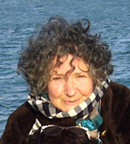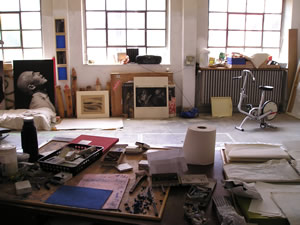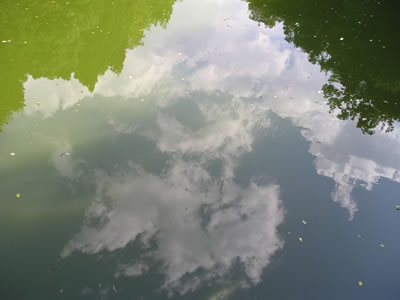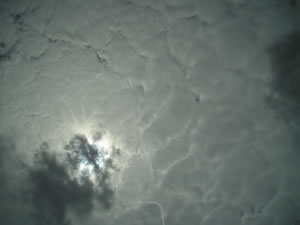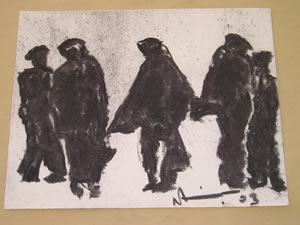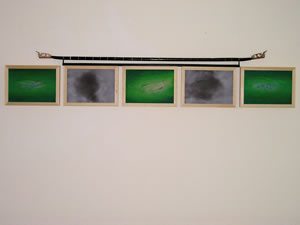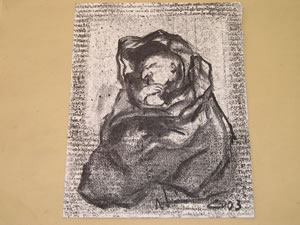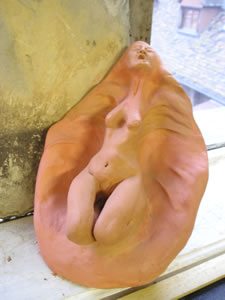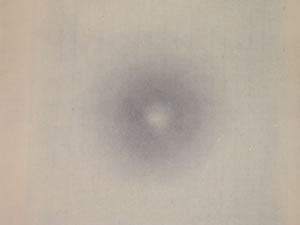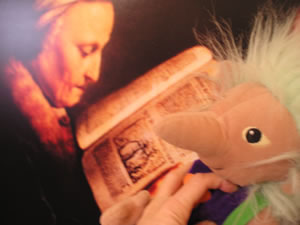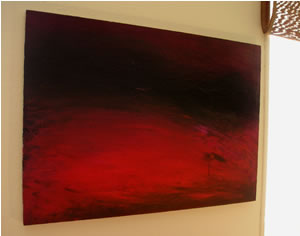 |
 |
 |
 |
 |
 |
 |
French artist, photographer and documentary maker Nourit Masson Sekine
Nourit Masson Sekine tells of her art and healing work using Chi Kung and Eastern Medicine and how they are used differently in France and Japan.
Q: How long did you live in Japan, and what was it like for you to return home? Could you apply the life experiences and new skills you had acquired in Japan.
I lived in Japan for nine years. I went back to France in 1990, (15 years ago already). To go back to France was not at all going back home. I left France when I was 17. I did my art studies and other experimental things in Israel.
Nourit's art studio in FranceI was always very passionate about therapy, medicine and psychology. I was involved in it from the side, in term of formal studies, but very much into it, in terms of experimentations. For instance, I started psychotherapy and then, after one year the psychologist proposed a didactic study with her... I did things like that. I also worked in a poor area of Tel Aviv as a street educator, social worker and so on. So, to go back to your question, France was attractive because I never lived there as an "adult". It was a country to be reborn in. I was very uneasy because I had my own idea of France, which came from my childhood and teens. Culturally I have always been outside the mainstream even at school.
Nourit’s photographyThe first year in France was difficult because I didn't feel people could understand me, and they did not. Even my language was too rich, full of many cultural influences from the Hebrew language and the Japanese language. My French was very sensorial, but also the deeper meaning involved knowledge from others times and other spaces. It was funny, I had to give "subtitles" all the time. On the one hand my expectations as an "oriental" woman was of more "hospitality" in the ethical way to relate to people... and for that France is not the ideal country!
But of course, my skills could be applied. Especially the Chinese Medicine part of it... everybody likes to be touched, listened to, better understood. Most people, when they are in trouble, in the dark part of their consciousness, are willing to let a bit of light in, a new language. They are willing to change the way they view themselves.
Q. Most people know you as a photographer, artist and documentary maker. How did you become interested in Chi Kung and Eastern medicine as well?
I studied Aikido like many who come to Japan. I tried Tai Chi with a Master friend of mine. I could not appropriate it to my self. None of those really talked to me. When I tried Chi Kung for instance, it came from a Master who understood me well. Sei Kaku En, a Master from Shanghai. He was bright, with an irresistible sense of humor The encounter with Chi Kung came to me from his being. His Chi Kung could put me in mine, that is why from 1987 onwards, I studied with him. His philosophical way of expressing and all the secrets I had the privilege to receive from him in order to discover the meaning of it within my own evolution and growth.
Nourit's photographyI studied Shiatsu from Masunaga's student after my daughter's birth. I thought then that I should know how to take better care of her. I didn't have the chance to go to a Chinese Medicine and Acupuncture School. I didn't have the time, and could not read Japanese well enough anyway. I had so much work with my art, exhibitions and projects with Butoh dancers, so I had to stay realistic. And yet I spent one year studying Shiatsu at The Kimura Institute. But I didn't think it was very "therapeutic". It was just nice, agreeable and even necessary when one is too stressed. But not much more than that in terms of various pathologies.
Then I was introduced to Akahigedo Clinic owner Master Takeuchi. At that time I was not feeling well at all, and life in Japan had brought a syndrome that I found in many other friends living in Japan called "spasmophilia" – but at that time I didn't know what is happening to me. It was actually nothing bad medically, but a spectacular way in which my body to expressed "too much". The non-adapted way of life I was into at that time regarding proper rhythm, sleep, nutrition etc. Working a lot, moving a lot, and yet without the conditions of appeasement Japanese could have. With the same stress, in the ritualizing of their everyday life – family, feasts, temples, their mother tongue, the way they eat, the "amae" relation to life and "tutti quanti".
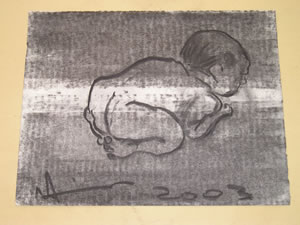
Illustration by Nourit Masson SekineSo, I met Takeuchi and immediately we became friends. Thanks to his treatment, I could suddenly understand all of what I didn't get during my first shiatsu studies. All the elements came together in me and I understood how shiatsu could be a real therapy. So Akahigedo is, still today a place where I can go and learn, even just by watching the way Takeuchi relates to his patients and to therapy. And not by chance, I believe, it is the place I met the Master of Chi Kung I told you about.
I also studied what I called "Zen hypnosis" with a psychologist and Zen Buddhist master, Osaki-sensei. He was also an English teacher who didn't speak English actually. I did therapy with him for half year and then studied with him until I left Japan. It taught me a lot because the point of view of the therapy included Western concepts, but in a Japanese way. Through him I learned a lot about the Japanese conscious and unconscious psyche. I had more theoretical exchanges with him than with the shiatsu world about therapy.
Illustration by Nourit Masson Sekine
I treat and I teach when I do not paint or write and work in the art field. But there is no difference for me between the two. Medicine is an art too. To treat and accompany people, listening, observing, creating links between the elements of life is a basic approach. As written in the Kabala, "God has created the sickness and the medicine within the body".A doctor can never know why the treatment works sometimes and other times does not. That shows the freedom of the being. Of course a poison will kill. That’s a science fact. But human life is a mystery in many ways. Each life has it's own secrets.
A therapist who accompanies a person has to just be there and use his knowledge and technical skills first. So I use techniques. But even when I teach techniques, I also teach the Chi Kung of the same technique. To touch someones body is not a banal act. It has to be done with respect and concern for a persons limits. How can we touch and give the sensation of security and steadiness, love and listening. That's what consciousness is about when it comes to practical action. But how do you understand that intellectually and through the senses?
Art by Nourit Masson SekineA symptom has a meaning. It expresses that something is wrong. And the symptom needs to be there until something is understood in depth. Until that the person can transform and give up the expression of what was wrong. If the cause is not there, the symptom can disappear, since it has nothing to express anymore.
So who decides whether a symptom for which someone goes to treatment for should to be taken away? The answer is not always obvious and has to be checked using intuition. We train our intuition in order to become knowledgeable about this matter. How do you stimulate the inner medicine within a sick body before acting on this body. We must respect of the right time for each person to cure his sickness.
Illustration by Nourit Masson SekineIf the therapist is not aware of that, then a chronic headache the patient was attached to for unconscious reasons may change into another issue. The headache disappears but not the cause, so one may get mononucleosis instead for instance. So, what I mean is that the therapy has to be holistic in order to prepare the body-mind to separate from the way and habit with which one can function because the sickness regulates him. If you are sick, you rest. When you are not sick, nobody takes care of you for instance, and you have no legitimate reason to fail or slow down.
Sculpture by Nourit Masson SekineNow you understand why a symptom is important right? It expresses not only the bodies condition but the psychological suffering that needs to be listened to. This is also why you do not always touch the pain where it is expressed, but go around to other parts of the body to help the symptom to be more bearable. Then it takes the needed time to input other messages in the body. Among the messages are the care itself, the time to improve your condition, the love you get from being touched.
As you know touching is perceived as a very archaic thing. As we have experienced it at birth and in early stages of life, the power of touch is enormous.
Q. Do you notice any big differences between the way Eastern Medicine and Chi Kung is practiced in Japan and in France?Some differences. The relationship with pain for instance. Western men hate pain and get worried when they feel pain. Women, as you know, are better at enduring pain.
Illustration by Nourit Masson SekineCompared with the West, it is clear that in the East are less into language than in the West. So psychotherapy in the West gets into the touch therapy than in the East. A different meaning given to what is said. Maybe a less pragmatic relationship to words and language. The West is more rational, more cerebral.
If you ask a French person to empty the mind… they don't know what it means. So they ask questions... but who can give the answers? Nobody.
In Japan you can ask someone to provoke "mu" in his mind. Immediately you see his mouth opening like a baby, relaxed and out into... "mu" I guess.
In France they will imitate a form and make some terrible faces with the eyes revulsed and white like one trained in Zen. So I talk about feeling "drunkenness". They understand better!!! But I'm not sure they can do it with no wine!!! They will think about it though...
Q. The art of touch is something almost taken for granted in Japan, where shiatsu and other hands-on healing methods are widely trusted. Why do you think Europeans are so skeptical or even afraid of touch?
Inhibition! Touch means sex, libido. As you know, it is a Christian Culture. The body has meant passions and dirty thoughts to Christians for centuries. It means guilt. Touch is intimacy. There is a fear of being seen; exposing hidden passions and uncontrolled feelings.
Puppet created by Nourit Masson SekineThis is why the approach of touch I have developed is very concerned with that particular culture and psychology. But are the differences so big today with Japan? I don't know – it has to be studied more seriously. The fear of pain too, and the rejection of pain. It depends on which generation we are talking about. The Chinese and Japanese of ancient times were definitely better at taking pain. No place for the ego to express itself. The consciousness of "individuality" as a psychological and social concept changes the relationship to the body and "touching".
Q. Has your life changed as a result of having Eastern Healing/ Chi Kung in your life?
Yes of course!!! A lot! Every important meeting has changed my life. The two I have mentioned did. Studying changes ones life. It is not Eastern Medicine or Chi Kung in itself but all the philosophies and teachings it contains. It is always the voices and the faces of the ones who carried the knowledge to me that changes my life. The right person at the right moment...
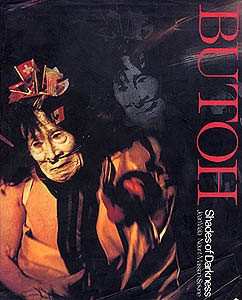 |
Butoh: Shades of Darkness - Nourit's book
Q. Is there a special teacher or mentor in Japan or in France that you to continue to study with?
In France, I started studying Judaist thinking and Kabala. I had a Kabala Master. But he died one year after we met. Intellectually I am more fed in France than in Japan. But on a wider dimension, humanly, I feel more fed in Japan. And I don't need to stay long in Japan, in just one week I can be refilled with this "something" I do not get here in France. I miss it. The hospitality, the generosity, the non-mental, the share out of time where it is in a flux.
Art by Nourit Masson SekineBut in France I learn a lot from my teaching. Sometimes when I teach I feel that I am my own student, like my other students! There are things I know that I transmit, but also things I don't expect happen too. Expressed in a formalized way for the first time... I must be lucky to have me as a teacher too!
I am grateful to my students, without whom I would not be making my many discoveries during the teaching in process!
To see Nourit Masson-Sekine's Website: www.nouritms.fr
Home
•
Naturopath •
Aromatherapist •
SHOPPING ONLINE • Contact
Us
Healers,
Teachers & Creative People • Magazine
- Online • Useful
Info
Meditation,
Mantras & Prayer • Vegetarian
Info • Famous
Vegetarians •
Links

